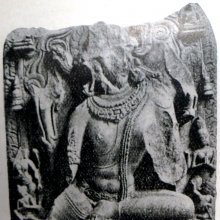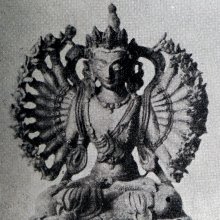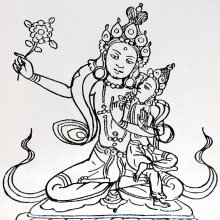Shaktimudra, Śaktimudrā, Shakti-mudra: 2 definitions
Introduction:
Shaktimudra means something in Hinduism, Sanskrit. If you want to know the exact meaning, history, etymology or English translation of this term then check out the descriptions on this page. Add your comment or reference to a book if you want to contribute to this summary article.
The Sanskrit term Śaktimudrā can be transliterated into English as Saktimudra or Shaktimudra, using the IAST transliteration scheme (?).
Images (photo gallery)
In Hinduism
Pancaratra (worship of Nārāyaṇa)
Source: archive.org: Isvara Samhita Vol 5Śaktimudrā (शक्तिमुद्रा) or simply Śakti is the name of a mudrā described in the Īśvarasaṃhitā 36-38.—Accordingly, “the fingers, in the left hand, lying on their back and remaining separately and stretched out, are to be bent down, so that the thumb could be like a bridge from the edge, could face in the fingers clinging to the middle. This shall be formed to face the heart and it is śaktimudrā offering pleasure. Understand this in the case of Śrī and other beginning from the forefinger to the little finger”.
Mūdra (eg., Śaktimudrā) is so called as it gives joy to the tattvas in the form of karman for those who offer spotless worship, drive out the defects which move about within and without and sealing up of what is done.
Source: archive.org: Catalogue of Pancaratra Agama Texts1) Śaktimudrā (शक्तिमुद्रा) is the name of a Ritual Hand-gesture (mudrā), discussed in the twenty-fourth chapter of the Īśvarasaṃhitā (printed edition), a Pāñcarātra work in 8200 verses and 24 chapters dealing with topics such as routines of temple worship, major and minor festivals, temple-building and initiation.—Description of the chapter [mudrā-lakṣaṇa-bhagavaddhyāna-ādi-prakāra]: Nārada tells how one prepares himself for the practice of mudrā-gestures—washing the hands with sandal-paste, doing certain exercises with the fingers, ritually touching the chest with the thumbs and forefingers of both hands, executing certain motions with the palms joined, etc. (3-11). Different mudrā-gestures are named and described (12-72): [e.g., śaktimudrā (38a)] [...]
2) Śaktimudrā (शक्तिमुद्रा) also refers to one of the twenty-six “ritual hand gestures” (mudrās) mentioned in the sixth chapter of the Nāradīyasaṃhitā: a Pāñcarātra document comprising over 3000 verses in 30 chapters presenting in a narrative framework the teachings of Nārada to Gautama, dealing primarily with modes of worship and festivals.—Description of the chapter [mudrā-lakṣaṇa]: Gautama asks Nārada about mudrās, by using which one can please the Lord (1) Nārada then names and describes how to form with the hands 26 gestures: namely, [e.g., śaktimudrā] [....]. All the preceding are mudrās appropriate to use when worshipping the Lord in His central shrine.
3) Śaktimudrā (शक्तिमुद्रा) is the name of a Mudrā (“ritual hand-gestures”) mentioned in in chapter 13 of the Viśvāmitrasaṃhitā: a Pāñcarātra text comprising some 2600 Sanskrit verses covering topics such as initiation (dīkṣā) and the construction, decoration and consecration of temples and icons, as well as routines of regular and special worship cycles.—Description of the chapter [mudrā-adhyāya]: Kāśyapa asks what are the various types of mudrā-gestures, and Viśvāmitra complies by first defining mudrā as that by seeing which one derives pleasure (“mu-”) and then by counseling that whoever practices these mudrās must do so in secrecy (1-6). Thereupon he names and briefly describes how to perform a number of mudrās [e.g., śaktimudrā]
4) Śaktimudrā (शक्तिमुद्रा) refers to one of the 81 Mudrās (hand-gestures) described in chapter 2 of the Ṛṣirātra section of the Sanatkumārasaṃhitā: an encyclopedic Sanskrit text written in over 3500 verses dealing with a variety of topics such as yoga, temple-building, consecration ceremonies, initiation and dhanurveda (martial arts).—[Cf. the chapter mudrā-lakṣaṇa].
5) Śaktimudrā (शक्तिमुद्रा) refers to one of the 81 Mudrās (hand-gestures) described in chapter 2 of the Ṛṣirātra section of the Sanatkumārasaṃhitā: an encyclopedic Sanskrit text written in over 3500 verses dealing with a variety of topics such as yoga, temple-building, consecration ceremonies, initiation and dhanurveda (martial arts).—[Cf. the chapter mudrā-lakṣaṇa].

Pancaratra (पाञ्चरात्र, pāñcarātra) represents a tradition of Hinduism where Narayana is revered and worshipped. Closeley related to Vaishnavism, the Pancaratra literature includes various Agamas and tantras incorporating many Vaishnava philosophies.
See also (Relevant definitions)
Partial matches: Mudra, Shakti.
Query error!
Full-text: Shakti.
Relevant text
Search found 4 books and stories containing Shaktimudra, Śakti-mudrā, Sakti-mudra, Śaktimudrā, Saktimudra, Shakti-mudra; (plurals include: Shaktimudras, mudrās, mudras, Śaktimudrās, Saktimudras). You can also click to the full overview containing English textual excerpts. Below are direct links for the most relevant articles:
Cosmetics, Costumes and Ornaments in Ancient India (by Remadevi. O.)
2.6. Various other Finger Ornaments < [Chapter 3 - Ornaments]
Cidgaganacandrika (study) (by S. Mahalakshmi)
Verse 44 [Transformation of Vyomeśvari] < [Chapter 2 - Second Vimarśa]
The Indian Buddhist Iconography (by Benoytosh Bhattachacharyya)
International Ayurvedic Medical Journal
The role of ayurveda in the management of parkinson’s disease- a review article < [2016, Issue XI November]


